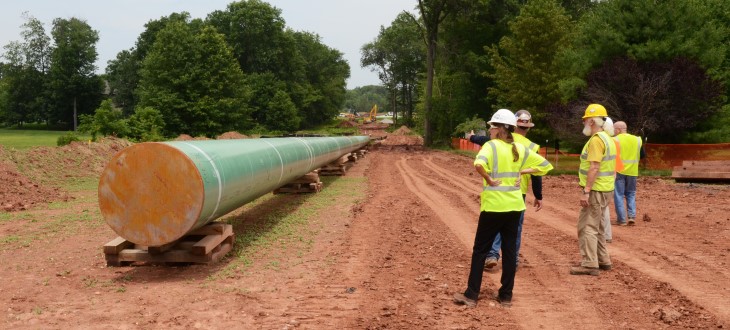The State We're In
Gas pipelines carry hidden costs: ‘A tale of two pipelines’
Someone once said “the best things in life are free.” But even “free” things like air, water and the quiet enjoyment of nature have tremendous value. And those values can easily be stripped away.
That’s the finding of a new report commissioned by New Jersey Conservation Foundation on the costs of natural gas pipelines and associated infrastructure in the Delaware River Basin, a region covering over 14,000 square miles in New Jersey, Pennsylvania, New York and Delaware. This region provides drinking water to more than 15 million people.
The report shows that two pipelines alone – the proposed PennEast pipeline in New Jersey and Pennsylvania, and the newly-built Mariner East 2 pipelines terminating near Philadelphia – could cost communities up to $2.4 billion in environmental damage and lost services.
“Such costs should not be overlooked when making decisions about pipeline development in the region,” warns the report conducted by The Cadmus Group LLC, an independent technical consultant based in Massachusetts.
Here are some examples of costs cited in the report:
- Loss of “ecosystem services,” including flood control and water purification;
- Increased emissions of methane and other greenhouse gases that pollute the air and contribute to climate change;
- Lost investments in preserved parks and farmland seized for pipeline construction;
- Lost public recreation days resulting from pipeline construction.
And that’s just the “tip of the iceberg.”
The report notes other costs that aren’t easily quantified, like treating contaminated drinking water, finding new water supply sources, restoring degraded wildlife habitats, decreased property values, and the stress placed on communities by construction-related noise, vibrations and unsightly aesthetics.
“This new report lays to rest any argument that PennEast would benefit the people of New Jersey or Pennsylvania,” said Joseph Otis Minott, executive director of the nonprofit Clean Air Council. “As we’ve learned from the horrific impacts of Mariner East, the costs to our land, water, health, and economy far outweigh the corporate profit from these pipeline projects.”
The cost of greenhouse gas emissions from the two pipelines is astronomical. The report estimates the “social cost” of carbon pollution in the Delaware River Basin at up to $1.4 billion for the PennEast pipeline and up to $800 million for the Mariner East 2 pipeline.
The social cost of carbon is a measure of the economic harm caused by greenhouse gas emissions, including extreme weather events like flooding and deadly storms, sea level rise, the spread of disease, failed crops, and higher food and health care costs.
Together, the PennEast and Mariner East 2 pipelines would impact about 2,200 acres of land in the Delaware River Basin. Each mile of pipeline directly disturbs 12 acres, leading to forest fragmentation and a loss of wildlife diversity.
The report estimates the value of lost ecosystem services in the Basin from the two pipelines at about $53 million.
According to the report, increased sediment from pipeline construction in streams that feed into the D&R Canal and the Delaware River may create additional costs for water treatment systems.
Construction of the Mariner East 2 pipelines has already shown that these risks are real. As of February 2019, about 240 “inadvertent returns of drilling fluid” – mud and chemicals that spill into waterways – along the Mariner East 2 route were reported. The Pennsylvania Department of Environmental Protection has issued 94 notices of permit violations and many homeowners have lost their drinking water wells.
The PennEast pipeline route would cross 135 streams in the Delaware River Basin, and the Mariner East route crosses 72 streams. These stream crossings threaten water quality and raise concerns for native species like trout and long-tailed salamanders.
Six federally-listed endangered and threatened species and 25 state-listed species would face habitat disruption from the construction and operation of PennEast. In total, PennEast would cross or come within 100 feet of six important bird areas, including Baldpate Mountain in Mercer County. The Mariner East 2 pipelines cross or come within 100 feet of four important bird areas.
The economic value of farmland disturbed by the pipelines would total approximately $4 million, based on average farm real estate values in Pennsylvania and New Jersey. In addition, the pipelines could cost recreation goers approximately $2.8 million in lost recreation enjoyment during construction.
The Cadmus Group report represents the first comprehensive look at the total environmental and social costs associated with PennEast and Mariner East 2.
Let’s hope this “Tale of Two Pipelines” is enough to convince those in charge that corporate bottom lines should not be allowed to trump clean environments and public health. The costs are far too high!
To read the full Cadmus report, go to https://rethinkenergynj.org/wp-content/uploads/2019/06/Costs_of_Pipeline_Development_in_the_DRB_FINAL.pdf
To learn more about pipeline threats – and why clean, renewable energy is New Jersey’s best choice – visit the ReThink Energy NJ website at www.rethinkenergynj.org.
And for information about preserving New Jersey’s land and natural resources, visit the New Jersey Conservation Foundation website at www.njconservation.org or contact me at info@njconservation.org.
About the Authors
Alison Mitchell
Co-Executive Director
John S. Watson, Jr.
Co-Executive Director
Tom Gilbert
Co-Executive Director, 2022-2023
Michele S. Byers
Executive Director, 1999-2021
View their full bios here.
Filter
Get The Latest News
From The Garden State
In the
News

